Designing Buildings for Wheelchair Access
Disabled Wheelchair Access In Building Design
People can be disabled in many different ways and to different degrees. Disabilities can severely restrict a disabled person's ability to enter and move around in buildings. Through careful design of access ramps, floors, corridors, doorways, toilets and washrooms disabled people can be provided with access and mobility.
Here we look at good disabled access design and design parameters and appropriate dimensions.
Understanding the problems of disabilities
Do you ever stop to think what it would be like to be disabled?
We have all had a bad back from time to time but have you ever thought what it would be like to be stuck in a wheelchair for the rest of your life? It is something that could happen to any one of us at any time.
Being realistic most people have never tried to use a wheelchair and find it difficult to fully appreciate the ramifications of even small obstacles. Steps are obvious but of course they are not the only hazard faced by wheelchair dwellers on a daily basis with doorways not wide enough, surfaces like gravel or cobbles to cross and trying to get into a public toilet or an aeroplane may bring their own unique challenges.
Growing awareness and change
Here in Bali disabled access has tended to be a design blind spot in the past but things are changing for the better and more and more new buildings are incorporating disabled design principles (no I am not referring to architects with disabled minds although there do seem to be a few of those around).
There is still a long way to go and only yesterday I passed a brand new hotel and, just through interest, I thought I'd check the wheelchair access. There wasn't a single access point around the hotel where a wheelchair could enter except down the very steep ramp into the underground carpark.
Have a look at the newly built pavements around Bali and you will find that most of them are very poorly designed. Many are an obstacle course even for able bodied people and a nightmare for our poor wheelchair bound fellow human beings.
As awareness grows we can expect that more and more buildings will need to be modified to provide facilities for disabled people. Wheelchair access is probably the most obvious (and challenging) so let us look at design considerations for wheelchair bound people.
Dimensions of a standard wheelchair
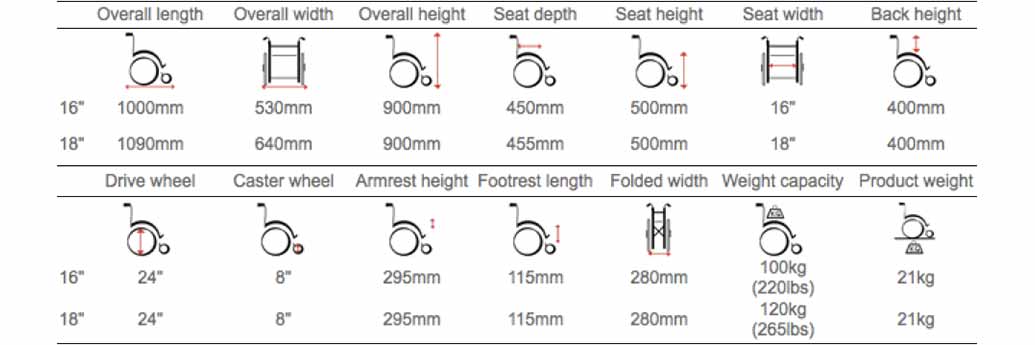
We can start with the dimensions of a standard wheelchair. Wheelchairs come in different sizes to suit everything both children and adults. We can, however, expect a wheelchair to have the following dimensions:
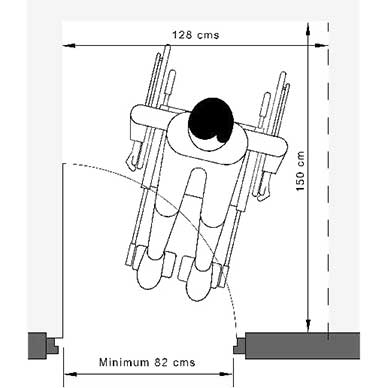
- Overall length of wheelchair 100 cms to 109 cms
- Overall width 53 to 64 cms
- Toe height 20 cms
- Seat width 41 to 46 cms
- Seat height above the ground 48 to 50 cms
- Height of handles 90 to 92 cms
- Height of armrests 76 to 80 cms
- Width between footrests 45 cms
The most obvious variable is in the width of the seat depending on the size of the occupant. We also have to consider that when a person sits in a wheelchair their toes will protrude 15 cms in front of the footrests, their arms and hands will protrude from the sides of the wheelchair and their lap will be 20 to 22 cms above the seat.
Sound building design needs to allow for movement of wheelchairs around the building. Things to consider are:
Design Considerations
- At all times there needs to be sufficient room for the width of the wheelchair plus the occupant's hands to turn the wheels or operate the brakes.
- There needs to be enough room around doorways to get to the door handle and to manoeuver the chair out of the way of the door swing.
- There should be no bumps or grills with slots to trap the wheels.
- Slopes must not be too steep or too long.
- There need to be grab rails to provide assistance when on slopes or getting on and off toilets.
- Washbasins need to be hung out from walls with enough gap underneath to allow the seated wheelchair dweller to get under the washbasin to get close enough to wash their face.
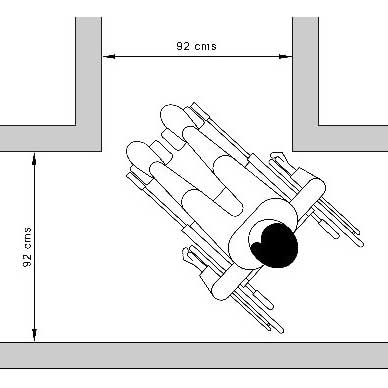
Doorways for wheelchair access
Doorways need to be wide enough to allow the wheelchair through with both hands on the wheelrails. The width of a doorway for wheelchair access should be a minimum of 82 cms. There also needs to be sufficient room for manoeuvering to allow the occupant to get to the door handle and open the door.
Wheelchair access in corridors
Corridors need to be a minimum of 92 cms wide for single wheelchair movement however they need to be wider if they need to allow for people getting past the wheelchair or even for two wheelchairs to pass each other (this can be avoided if there is a manoeuvering space where one wheelchair can park).
A corridor for wheelchair access with a right angle bend in it will need to be wider to allow the wheelchair to get around the corner (unless it is a rubber wheelchair).
Disabled car parking spaces
To allow a disabled person to get out of a car and into a wheelchair a disabled parking bay needs an aisle a minimum of 1.5 metres wide between parked cars.
Disabled toilet dimensions
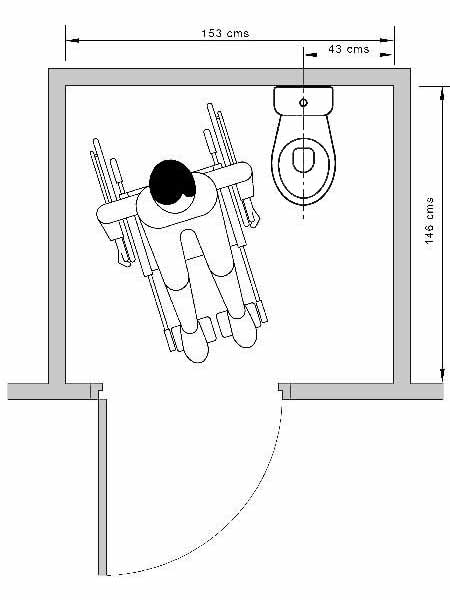
Wheelchair accessible disabled toilets need sufficient space to allow the wheelchair to enter, to close the door (and remember the door is extra wide so it has a large arc of swing) and to manouever to be next to the toilet pan. The seat of the toilet must be about the same height as the wheelchair seat. Typical dimensions are:
width 152cm (60")
depth 132cm (52")
doorway width 82 cms
The toilet should be to one side with centre line of toilet 41 cms to 46 cms away from wall
with a grab rail on the wall 84 cms to 92 cms above floor.
Design of ramps for disabled access
Ramps are being used to replace or augment steps in many situations. It is important that the slope is gentle enough for a wheelchair person to get themselves up the ramp, that there is a enough room to manouver at the bottom, top and any corners of the ramp. It is also important that there is some protection to stop the wheelchair running of the ramp.
1. A wheelchair ramp should be no steeper than 1:12.
2. Maximum height rise of the ramp before there is a level rest place (a landing) should be 75 cms (this is a horizontal distance of 9 metres if the slope is 1:12).
3. Landings should be provided at the bottom, top, turns in the ramp and at rest places, these should be at least 1.5 metres long to be effective.
4. A ramp should be at least 92 cms wide (between handrails) and if the ramps rises more than 15 cms handrails should be provided.
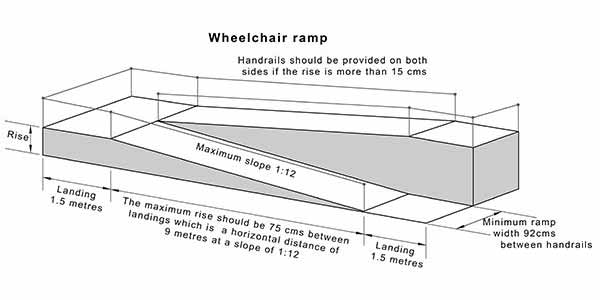
Road, path and floor surfaces
Finally don't forget to consider surfaces, sand and gravel are very difficult. Cobbles seem to be making a comeback, I have noticed quite a few places where small square cobblestones are being used for car parking spaces or access roads to hotels and villas. Try pushing a person in a wheelchair over gravel or cobblestones and you will quickly realise that it is very difficult, it's worse than fighting that supermarket trolley that inevitable has a wheel or two with a mind of its own.
Phil Wilson
Copyright © Phil Wilson July 2014
This article, or any part of it, cannot be copied or reproduced without permission from the copyright owner.
